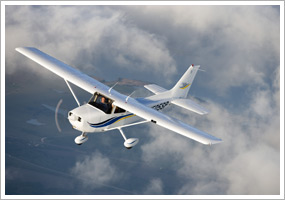training tips  Taking on turbulence Taking on turbulence Few pilots wake up in the morning and say, “It’s going to be a very bumpy day. I should get out there and fly!” One exception may be your flight instructor, who at a certain point in your training may be thinking along those exact lines. The traditional introduction of a new pilot to the lumps and bumps of an atmosphere on the move is gradual, or at least unpredictable—not a lesson plan in itself. But turbulence is a fact of life of aviation weather, so the sooner a pilot gets used to the idea that turbulence and its ergonomic discomforts may arise at any time, the better. Getting ready to fly when the bumps are already known to be out there is part preflight planning, part mental prep. How should you adjust your piloting technique? How does your aircraft behave in bumpy air? Begin your research with a glance out your kitchen window. Stratiform clouds often tell a story of stable, smooth air. Cumulus clouds suggest convective currents and thermal turbulence, especially during warm weather. Altocumulus standing lenticular clouds developing downwind of mountains warn of severe turbulence. Next check precautionary statements in the area forecast (FA). They are discussed in Chapter 12 of the Pilot’s Handbook of Aeronautical Knowledge. Look over pilot reports from your briefing, noting the time, location, altitude, and type of aircraft involved. When preflighting, secure your baggage, for safety and to preserve a correct center of gravity. Be sure the baggage load does not exceed the published limit. “The limit is based primarily on the strength of the aircraft structure. It doesn't mean the floor will buckle if you put 201 pounds in a baggage hold limited to 200 pounds. It does mean that you increase the risk of overstressing the structure in extreme turbulence or under maximum certificated acceleration (G) loads,” wrote Mark Twombly in the November 2001 Flight Training column “What it looks like: When baggage is properly secured.” Try the Air Safety Institute’s online Aerodynamics course, which features an interactive weight-and-balance exercise. Windy day departures need specialized technique; review with your instructor. Read this AOPA Aviation Forum post of how one pilot’s experience made him question his method. Planning a long day’s ride? Prolonged flight in turbulence can bring on fatigue. Know the warning signs and stay alert. Training tames turbulence, producing a confident, more skillful pilot. training products Free Plane Manager app from Sporty’s Owning an airplane gives you a lot of freedom along with a lot of new record-keeping responsibilities. Sporty’s Plane Manager app, powered by ShareZen, can help you track maintenance, to-do lists, and other tasks via a secure online server. You also can use it to maintain an online logbook and keep track of your flying schedule. See the website for more information. Note: Products listed have not been evaluated by ePilot editors unless otherwise noted. AOPA assumes no responsibility for products or services listed or for claims or actions by manufacturers or vendors. final exam Question: What causes motion sickness, and what are the typical symptoms? Answer: Motion sickness is caused by the constant stimulation of the portion of the inner ear that controls an individual’s sense of balance. The symptoms are normally progressive. Usually the first indication of motion sickness is the loss of desire for food. Saliva then begins to collect in the mouth and the individual begins to perspire. Eventually, a person will feel nauseous and at times disoriented. One also might get a headache and/or vomit. It is possible to become completely incapacitated, if the motion sickness becomes severe enough. For more on motion sickness and what to do if one is suffering from its effects, read the AOPA subject report about motion sickness. Got a question for our technical services staff? E-mail [email protected] or call the Pilot Information Center, 800/872-2672. Don’t forget the online archive of “Final Exam” questions and answers, searchable by keyword or topic. |  Taking on turbulence
Taking on turbulence

